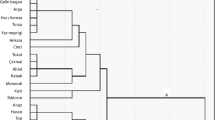Abstract
Seventy five accessions belonging to 14 species of the genus Cicer were analysed with PCR-based molecular markers to determine their phylogenetic relationships. Eight of the species were annuals and included the Section Monocicer which contains cultivated chickpea (Cicer arietinum L.). The remaining six species were perennials (five from Section Polycicer and one from Section Acanthocicer). More than one accession per species was analysed in most of the wild species; within C. arietinum, 26 accessions including Kabuli and Desi types, were studied. RAPD analyses using 12 primers gave 234 polymorphic fragments. Variability within species was detected. A dendrogram based on the Jaccard similarity index showed that the distribution pattern of variability between species was related to both growth habit and geographical origin. An accession of Cicer reticulatum was closer to accessions of Cicer echinospermum than to the four remaining of C. reticulatum, suggesting the possibility of gene flow between species. Cluster analysis for cultivated chickpea differentiated Kabuli and Desi types but we did not detect a clear relationship between groups and the geographical origin of the accessions.
Similar content being viewed by others
Author information
Authors and Affiliations
Additional information
Received: 5 April 2001 / Accepted: 13 July 2001
Rights and permissions
About this article
Cite this article
Iruela, M., Rubio, J., Cubero, J. et al. Phylogenetic analysis in the genus Cicer and cultivated chickpea using RAPD and ISSR markers. Theor Appl Genet 104, 643–651 (2002). https://doi.org/10.1007/s001220100751
Issue Date:
DOI: https://doi.org/10.1007/s001220100751




